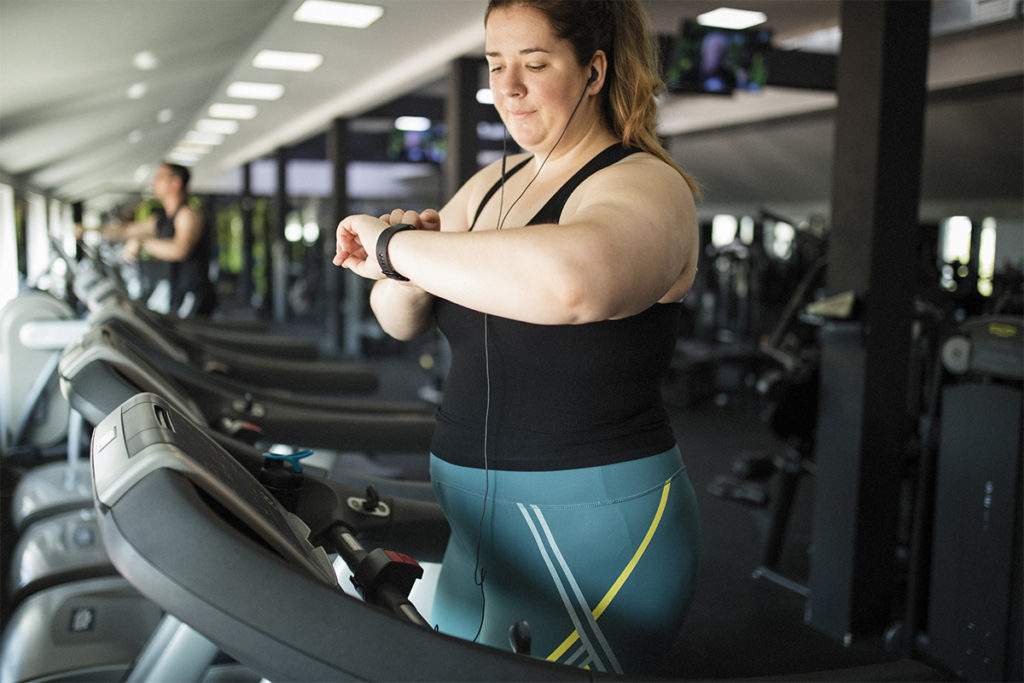Help Fight Freshman Weight Gain
How to assist first-year college students so they don’t pack on the dreaded “freshman 15” pounds.

College marks the transition from adolescence to adulthood, a time for increasing independence, pursuing dreams, exploring personal and professional goals—and for too many, less exercise and more girth, which gives rise to a phenomenon known as the “freshman 15” weight gain (Racette et al. 2008). In fact, when nearly 20,000 college students were surveyed at 33 U.S. schools, a mere 6.9% reported eating the recommended five or more servings of fruits and vegetables most days (American College Health Association [ACHA] 2005). Only 44% of the students said they engaged in 30 minutes of moderate or 20 minutes of vigorous exercise at least 3 days per week (ACHA 2005). While the freshman 15 phenomenon may be hyperbole—in actuality, college students gain an annual average of 4 pounds their first year (Levitsky, Halbmaier & Mrdjenovic 2004)—their weight increase that first year is still about six times more than that of an average adult in a single year (Mihalopoulos, Auinger & Klein 2008).
To help fledgling college students avoid the numerous undesirable health consequences of becoming overweight, it is vital to reach out to them as early as possible in their university careers to help them adopt a lifetime of healthy habits. Fitness professionals, especially those who work on college campuses or in college towns, are uniquely positioned to make a significant and lasting impact on the freshman class of 2008 and beyond.
The Facts About Freshmen
The first challenge when dealing with these stressed, newly independent, sleep-deprived and anxious young adults is to help put their freshman 15 fears to rest. Research suggests that students who are most concerned about gaining weight obsess about their weight, have a less favorable body image and categorize themselves as being overweight, even when they are not (Graham & Jones 2002). These findings only underscore how the freshman 15 myth itself can cause harm by inciting fear among many incoming students. Fitness professionals can help diffuse this weight obsession by focusing on the benefits of physical activity and healthful eating that extend beyond weight and physical appearance; for example, decreased stress, improved mood, enhanced efficiency and increased self-esteem.
Some amount of weight gain is a reality for most college students, and it should not go unchecked. A study of 290 incoming freshmen found that 70% gained an average of about 9 pounds from the beginning of their freshman year to the end of their sophomore year (Racette et al. 2005); other studies have reported much smaller average
gains (Holm-Denoma et al. 2008; Levitsky, Halbmaier & Mrdjenovic 2004; Mihalopoulos, Auinger & Klein 2008). Most of the weight gain tends to occur in the first semester of college (Holm-Denoma, et al. 2008; Levitsky, Halbmaier & Mrdjenovic 2004). In fact, researchers who studied 60 Cornell University freshmen found that an average increased daily intake of only 174 calories led to a 4-pound weight gain over the course of the first 12 weeks of the school year (Levitsky, Halbmaier & Mrdjenovic 2004).
Prevention Strategies
College is an opportune time for all students to develop a lifelong plan for health. Unfortunately, this time of life all too often becomes a gloomy gateway for a lifetime of adult weight struggles. Fitness professionals can help college students avoid weight gain and adopt healthy behaviors as early as freshman orientation day by increasing young adults’ awareness of the challenges that await them. Here are some of the typical challenges that college students face, along with workable solutions to avoid or minimize the obstacles.
Physical Activity Challenges
From tests that require endless hours of studying to a booked social calendar and the demands of extracurricular activities, it’s no wonder that many freshmen perceive that they have little time for exercise. While decreased physical activity plagues many adults of all ages, the steepest decline in exercise levels occurs in adolescence and young adulthood (Stephens, Jacobs & White 1985). As is the case for most busy people, successfully sustaining a fitness program while attending college means making exercise a priority.
Research suggests that the college students who are most likely to maintain an exercise program share several characteristics: high exercise self-efficacy (i.e., they have confidence in their ability to succeed in an exercise program); regular exercise participation during the past 12 months; and social support (Wallace et al. 2000). Family support appears to be most important for women, whereas the support of friends is the biggest motivator for men (Wallace et al. 2000).
Solutions. Here’s how fitness professionals can help freshmen develop or enhance these positive characteristics:
- Offer gender-specific fitness programs for college students to help increase their self-efficacy and comfort level; this especially applies to females, who are typically less physically active than their male counterparts (Wallace et al. 2000).
- Develop classes and sessions that emphasize peer support, such as discounted partner personal training. Also offer collaborative activities within classes, such as partner drills in a sports conditioning class, to enhance interaction and teamwork.
- Target inactive and sedentary students since they are the majority of the college population and the ones most likely to remain sedentary as adults if they are not “converted” prior to graduation (Wallace et al. 2000). Offer
introductory workshops and classes for students, and try especially to make newcomers feel at home and welcome in your facility. Consider a promotional “bring a friend” program in which active students are encouraged to invite a less active friend to participate in the activity.
- Offer educational workshops that inspire and instill an excitement for physical activity and exercise.
Nutrition Challenges
Even the most savvy and health-conscious students will find it daunting and overwhelming to maintain healthy eating habits and a proper diet during that first year on campus. Transitioning from life at home, where parents were responsible for preparing regular family meals, to a sudden smorgasbord of all-you-can-eat meal plans, nightly pizza outings and erratic schedules can create the perfect recipe for massive overconsumption.
Solutions. One way to help these students is to provide a steady diet of knowledge and education to overcome these challenges. Begin by referring students to www.mypyramidtracker.gov, where they can assess and track their current diet and physical activity status. If knowledge is power, the following advice will empower freshmen:
- Don’t skip meals. A hectic and erratic class schedule can make eating three square meals a day seem impossible. Plan ahead and keep a stash of food
in your dorm room so you can easily prepare a bagged lunch or quick breakfast; this can ward off late-night binging or excess calorie consumption later in the day.
- Avoid snacking when studying, socializing and pulling all-nighters. Junk snacks are often the food of choice in these situations. To tame that sweet tooth, try to portion the servings out (rather than dipping into an endless bowl of chips or M&Ms, for example), and choose lower-calorie versions of your favorite snacks whenever possible.
- Limit the pizza and alcohol. Pizza and beer are two staples of college life. If you can’t pass on the pizza, have fewer slices and opt for the plain cheese or veggie toppings instead of pepperoni or sausage. Adding a side of salad or vegetable toppings can help you get the recommended five servings a day. Since alcohol contains mostly empty calories, it should be consumed in moderation (or not at all) and only by those of legal age. To minimize the weight-gaining effects of alcohol, which contains about 80–150 calories or more per drink, drink slowly, alternate an alcoholic beverage with water or other calorie-free beverage, and
dilute mixers. Keep in mind that you shouldn’t “save up” calories for a night of partying, because drinking on an empty stomach increases the rate of alcohol absorption and can lead to harmful consequences.
- Recognize stress and emotional eating. Before you eat anything, HALT and ask yourself these questions: “Am I Hungry?” If so, then a healthy snack is in order. “Am I feeling Anxious, Lonely or Tired?” If the answer to any of these questions is yes, then your desire to eat is based on emotions, not hunger. To avoid binging on fast food, stash away a few healthy snacks, such as air-popped popcorn, baby carrots, frozen fruit bars or a whole fruit. If you do crave a specific food or snack, allow yourself to partake but keep things in moderation. If you find that you are frequently eating because of emotions, seek out campus health resources for help.
- Steer clear of vending machines and fast food. Although some fast foods can fit into a healthy eating plan, they should be reserved for special occasions and should not be the first or only
option. Again, plan ahead and carry extra healthy emergency snacks in a backpack so you aren’t even tempted.
Back to School
As this year’s freshman class descends on college campuses everywhere this month, fitness professionals have a golden opportunity to make a real difference. Reach out to students early in their college years, help them commit to a fun, effective and efficient workout program; and show them how to navigate the challenges of college dining halls. With your help, even the “freshman 4” will soon be no more.
Sidebar: Dealing in the Dining Hall
A college dining hall is brimming with nutrition challenges for students, especially freshmen. Anyone with even the slightest tendency for overeating can easily go astray with the all-you-can-eat buffet and the wide variety of food choices. Students can successfully navigate the dining hall by adopting this three-step process:
- Walk through the entire line first, taking note of what foods look appetizing and how various foods can fit into a balanced meal plan (check out the MyPyramid menu planner for help at www.mypyramidtracker.gov).
- Make only one trip through the line and select foods based on their nutritional value. For example, aim to include a protein, carbohydrate, fruit, vegetable and calcium-rich food at most meals (see the sidebar “A Sample Meal Plan” for healthy food choices at every meal), and choose low-fat options, wherever possible.
- Wait at least 10-20 minutes—the time it takes to feel full—before deciding to eat dessert.
A Sample Menu Plan

References
Graham, M.A., & Jones, A.L. 2002. Freshman 15: Valid theory or harmful myth? Journal of American College Health, 50 (4), 171–73.
Holm-Denoma, et al. 2008. The “freshman fifteen” (the “freshman five” actually): Predictors and possible explanations. Health Psychology, 27 (1), Suppl., S3–S9.
Levitsky, D.A., Halbmaier, C.A., & Mrdjenovic, G. 2004. The freshman weight gain: A model for the study of the epidemic of obesity. International Journal of Obesity, 28, 1435–42.
Mihalopoulos, N.L., Auinger, P., & Klein, J.D. 2008. The freshman 15: Is it real? Journal of American College Health, 56 (5), 531–33.
Mokdad, A.H., et al. 1999. The spread of the obesity epidemic in the United States, 1991–1998. The Journal of the American Medical Association, 282 (16), 1519–22.
Racette, S.B., et al. 2005. Weight changes, exercise, and dietary patterns during freshman and sophomore years of college. Journal of American College Health, 53 (6), 245–51.
Racette, S.B., et al. 2008. Changes in weight and health behaviors from freshman through senior year of college. Journal of Nutrition Education and Behavior, 40, 39–42.
Stephens T., Jacobs, D.R., & White, C.C. 1985. A descriptive epidemiology of leisure-time physical activity. Public Health Reports, 100 (2), 147–58.
Wallace, L.S., et al. 2000. Characteristics of exercise behavior among college students: Application of social cognitive theory to predicting stage of change. Preventive Medicine, 31, 494–505.
Natalie Digate Muth, MD, MPH, RD
"Natalie Digate Muth, MD, MPH, RDN, FAAP, is a board-certified pediatrician and obesity medicine physician, registered dietitian and health coach. She practices general pediatrics with a focus on healthy family routines, nutrition, physical activity and behavior change in North County, San Diego. She also serves as the senior advisor for healthcare solutions at the American Council on Exercise. Natalie is the author of five books and is committed to helping every child and family thrive. She is a strong advocate for systems and communities that support prevention and wellness across the lifespan, beginning at 9 months of age."






